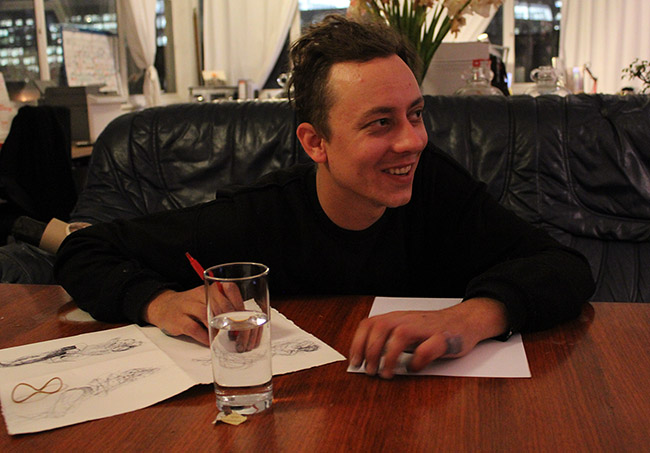
Street Art London: So let’s get this started.
Lister: Sounds great. Anthony Lister, November 15th 2012, the day before the Apocalypse.
Street Art London: I thought that was on the 20th? Anyway. First question, can you tell us a little about how you developed your unique style? Did you study fine art?
Lister: Yes, I did study fine art. Well, I guess I developed my styles with the frame of mind that I wanted to be able to still make art when I’m like old and handicapped. So I kind of wanted to feel comfortable just, you know, making things out of scribbles really. So I actually don’t really even call it drawing. I call it shapeshing. I kind of just push shapes around. I don’t know if that answered your question.
Street Art London: It’s almost like when you take a photo on low exposure you get this blurred image or what you might see when you’re drunk.
Lister: Yeah, well you know, one night I looked at one of my paintings and it was moving. And it really excited me. I knew that I was onto something then. I think I was a lot younger than I am now. It came to life, so I guess I just throw options out there as vapour trails of paths that could have been taken.
Street Art London: So it’s this thing about sort of mistakes and accidents within drawing but not necessarily seeing them as accidents?
Lister: Sure, well in Japan the word opportunity and problem are the same word. So I’m far more interested in problem creation than problem solution.
Street Art London: Problem creation?
Lister: Gives me something to do, doesn’t it?
Street Art London: That’s brilliant, I like that. So you started off doing graffiti as well, obviously. Earlier you were talking about Sofles and DTS was it?.
Lister: Sure, sure, I mean just those guys I grew up with painting in my hometown of Brisbane. But I didn’t start off with graffiti, I started off with just paper at my grandma’s house. She was a painter, just a hobbyist, and I always paid attention to her studio and I thought it was just a magical place. I’m not sure why. I grew up eating off placemats of beautiful Australian impressionists like Arthur Streeton. So I have always had just an awareness of painting and being encouraged to draw. But sure graffiti was thrown in there. By the time graffiti came around I was already the kid that could draw.
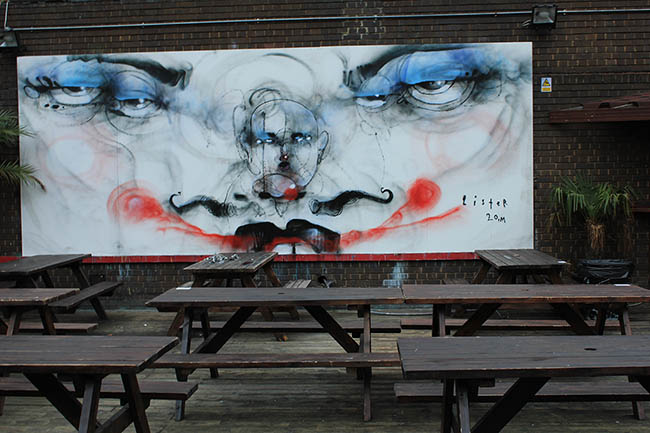
Truman Brewery (Nov 2012)
Street Art London: So it’s like a natural progression?
Lister: Yeah, scratching into things, that just comes naturally. Looking for them when you’re in the same place years later, that comes naturally too. You get better and deeper at scratching when things disappear.
Street Art London: Did you do a lot of scratchies then?
Lister: I will just naturally scratched into wood, you know, it’s just like a way to test the environment really. I’m into time travel. I figure, as a public interventionist, street artist, graffiti, artist whatever you call it, I figure that wherever I’ve been, there I am. And that’s the way I time travel for myself, you know.
Street Art London: So it’s a bit like an ideal of immortality as well? So you leave a piece somewhere and long after you passed on it’s still there…
Lister: Yeah, but you can’t expect that unless it’s a landmark.
Street Art London: Well, certain pieces can become landmarks can’t they? A lot of the Banksy’s around here, they are landmarks.
Lister: Yes, but they are still vulnerable to the fires of the apocalypse. Landmarks are more like like concrete, you know. I’ll stalk concrete.
Street Art London: Stalk it?
Lister: Yeah, I’ll wait for everyone to go. I’ll have the right tool.
Street Art London: And then carve into it?
Lister: Yeah, I’ll take my kids to do it and shit. Because, they’re the things, exactly, they’re the moments when you go, longevity and immortality. But you can’t really ever have them as a motivation. The motivation has just got to be the pleasure of being alive.
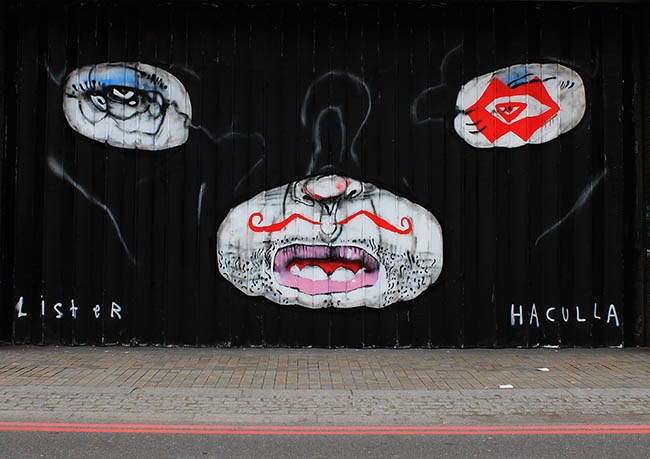
Curtain Road, Cordy House Shutters, with Hacculla (2011 – now gone)
Street Art London: So who are some of your artistic influences then? In terms of painters, musicians, directors and so on…
Lister: You know, Bukowski he’s a cool guy. Sigmund Freud’s a cool guy. Jimi Hendrix, you want to keep him in mind all the time.
Street Art London: Does that have to do with improvisation as well? The idea of the mistake?
Lister: I don’t even know, I just know the energies that I want to be paying attention to. Bob Dylan was cool in that interview with Time Magazine where he goes “it’s not my job, it’s not my job to do” you know “it’s gonna happen fast and I can’t explain it”. That was cool. Charles Manson said some interesting things too. But as far as artists go, Francis Bacon, he was a cool guy, he had some cool opinions, especially when he was drunk. He really said some bold things that were accurate and that everyone else was afraid to say. I was turned on to him by an artist called Brett Whitley who was an Australian artist who did the whole party art thing well before my time. You know, Rembrandt, Egon Schiele, you know, all the clichés and so on and so forth.
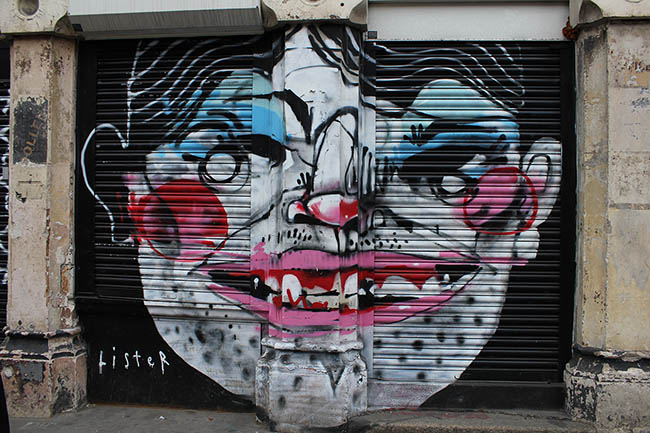
Commercial Street, Pictures on Walls Shutters (2011 – now gone)
Street Art London: You’re in London for your solo “Unslung Heroes” exhibition in both of The Outsiders gallery spaces. What is that exhibition about?
Lister: Well, the exhibition is about a bunch of works that I drew about a bunch of people. I sat around and drew. Their friends and colleagues and acquaintances. It’s party life drawing. I’ve been to life drawing since I was a kid just to understand anatomy because I enjoy it, nudity and drawing, it’s a great combination of things. Often I find myself with people and then drawing them as subjects.
Street Art London: Why is that?
Lister: Well, they move. Sometimes a static subject for me is kind of predictable and stale. You know what I mean?
Street Art London: So you don’t like still life drawing, for example?
Lister: No, I wouldn’t say I don’t like it, I guess I am more excited by people being distracted by having something to do. I feel like the energy of capturing their character. The drawings just come out fun, you know, and better.
Street Art London: A lot more candid perhaps.
Lister: I think it’s just authentic. I don’t get people to sit for me. Well, I do, but as soon as it’s conscious…. It takes the right muse to sit there and be occupied and not make a big deal of it. You know, it can turn into a thing and then it’s a bad energy to draw in.
Street Art London: So what is this obsession with superheroes then?
Lister: It’s just me making sense of the world and trying to raise kids to make sense of the world and finding analogies through contemporary media and influences that I’ve had, like Star Wars, comic books, heroes and villains, good and bad, power struggles. I think that’s about it. Mythology.
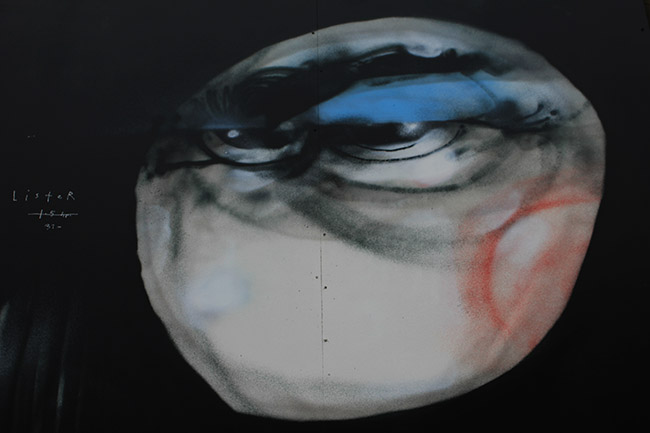
At Truman Brewery (Nov, 2012)
Street Art London: You did three pieces in London last week, well four now [SAL: and a few more since this interview]. One on Great Eastern Street and the two on the Old Truman Brewery off Brick Lane and Rivington Street today. Tell us a little about where you were going with these pieces?
Lister: Well they’re my public pieces and I’ve developed that part of my craft to just grind. I like to go out and you know I am just really fortunate and grateful to be able to get to paint here the way I have always wanted to. I mean I have been coming to London for years now and it hasn’t been so open, so. Where was I going with them? Well I mean there is the piece with the eyes on the wall and I would like to think someone would walk down there and feel like the alley is watching them.
Street Art London: Yes, well, it’s quite dark and even….
Lister: …. It’s ominous and dangers and scary. Not really, there’s security everywhere. I think before I did that [Truman Brewery] piece, I was informed by a sign that was on the wall where it said “beware, thieves operating in this area”. Almost like, look out, the birds will get your food! Don’t feed the birds… . classic. So you know, I paint street portraiture, I call it portrait landscape.
Street Art London: It’s obviously influenced by the context then.
Lister: At times.. No, I wouldn’t say….
Street Art London: I mean, because you saw that sign and then…
Lister: OK, it’s true but it’s not always so literal in terms of how things are delivered and presented to me. You know, if it was so literal, then I would have a reason for everything and then I would feel like I was a manipulator, because I had a plan or something. Honestly, I like to remain open when I’m creating work to the very last point. I like to leave the decision to the very end.
Street Art London: So you rarely have a plan then? You don’t really have an idea what you are going to paint before you start painting it?
Lister: Well, I wouldn’t say that. I’d say I never have a plan. And that is adventure painting. And I only have the power to land dope shit when I’m landing it because I surrender to the god of adventure painting.
Street Art London: I keep coming back to this idea in my mind of improvisation and jazz. Like when you painted the wall on Rivington Street and you introduced the Banksy style. That kind of emerged out of what you were painting.
Lister: Well, there was a line at first. Some line came across the whole painting and I didn’t know why or where it was coming from and I stood back and it was a vibration from his [Banksy’s] piece. The line was across the whole wall. It wanted to come out, it made that decision and I saw its relationship and it grew from there.
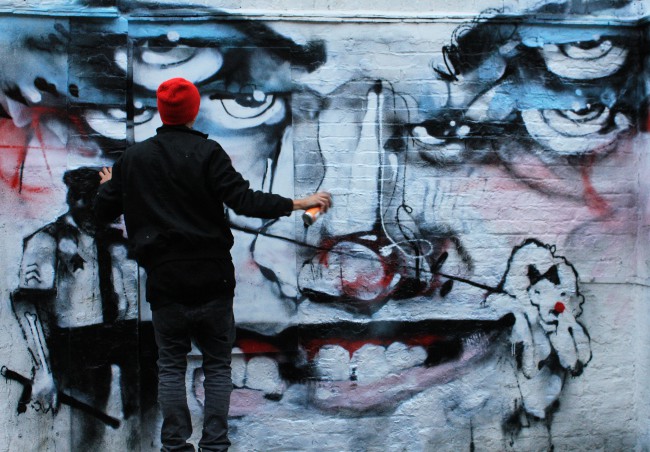
Rivington Street, ‘Lister is over stencils’ (Nov 2012)
Street Art London: So it’s quite subconscious then?
Lister: I would say psychic.
Street Art London: Did you know the Banksy piece was over there?
Lister: No, well, I did after I started painting. I was blown away that it was there. You know, I can’t explain how and it’s just one of these things. I’m just really happy to be there, really, really, I’m flattered.
Street Art London: We were talking about automatic drawing earlier today and perhaps that is quite close to the idea of the adventure painting, as you call it.
Lister: I think I always do automatic drawing. It’s just shapes, it’s shapeshing to me. Pushing shapes around. Things are just shapes. I don’t consider myself the draftsman. To say that I am drawing would be to give me too much credit for it. You’re just a channel. I’m just a channel.
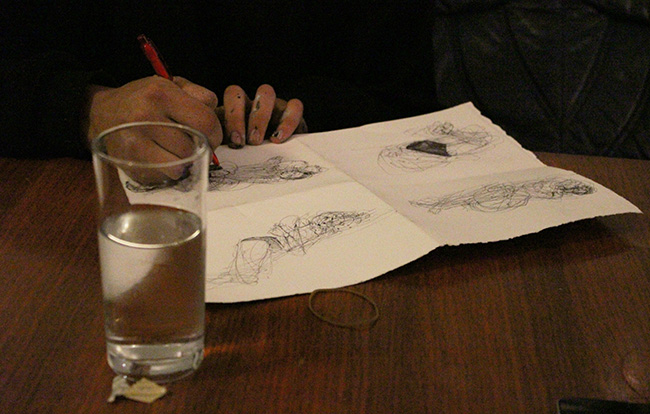
‘Interview time’
Street Art London: Yes, anything else you would like to talk to about….
Lister: Well, I’m interested in philosophy.
Street Art London: What kind of philosophy?
Lister: White trash-philosophy.
Street Art London: What is white trash-philosophy?
Lister: Like real life. Like Eminem. But I’m not going to quote him. I’ll quote Albert Einstein, who said “Imagination is far more powerful than knowledge”. And someone else, said something else, you know, quotes are like jokes, they are easily forgettable. OK, Martin Luther King: “Guided missiles, misguided men”. We are living in a society that I don’t know exactly how to grow old in. I’m not sure it’s going to be all right. Trying to see the future and I’m not sure that the authoritarian figures have been de-powered enough, destabilised enough. I don’t think we’ve reached that point of evolution yet. With police and security actually being useful and cleaning as they watch for danger.
[Lister breaks into song] “I’m an alligator!”
Street Art London: Who is that?
Lister: Bowie.
Street Art London: What kind of music are you into?
Lister: Mainly classical. Mozart
Street Art London: Who else?
Lister: I’m into Thelonious Monk. I’m into Black Flag. I’m into songs that begin with the letter S
Street Art London: Really?
Lister: At the moment.
Street Art London: Songs that begin with the letter S….
Lister: I’ll just go to that letter in my thing and just let it go. Next week it may be T or something.
Street Art London: Like Picasso’s blue phase or something…..
Lister: Picasso,what did he say? Ah, “Everything you imagine is real”. But he was a biter….
Street Art London: Everyone is a biter really aren’t they?
Lister: Well, I don’t know. Some people work very hard to maintain a pseudo original style. I try to be educated about what I am building as far as what aesthetics are coming in. You don’t want your cards to fall from under your feet and find out that someone has been doing what you do. That just makes you wake up in sweats and shit. So I work very hard at not copying actually. If I am attracted to something I’ll actually enjoy it, celebrate it, congratulate the artist and walk away. I’ll dissect it, but I definitely won’t go and try to emulate it and I think that’s what biting is, it’s straight copying. But… yes I did used to… I DREW BART SIMPSON, IT’S TRUE. I DREW A PICTURE OF BART SIMPSON and I bit Banksy today, I’m a walking contradiction.
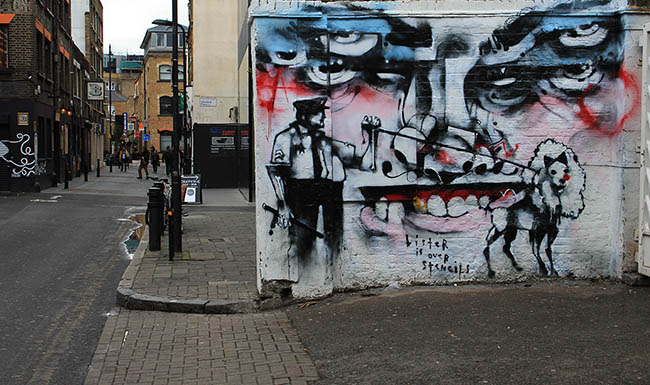
Rivington Street (Nov 2012)
Street Art London: Perhaps, it’s not about what you bite but how you bite it.
Lister: Well, everyone’s got to eat.
Street Art London: Nice little soundbite there. That could be the title of a painting.
Lister: Titles of paintings, that’s what I live for. ‘The beauty of failure’. That’s what I chase, the titles of paintings. You get three points of power when you create work. You get to make the work. You get to title the work. You paint a big black cock on a canvas and you call it happy wife. It changes. You get a different idea about the painting. It changes it. That’s a point of power. Then you get to hang it. You could either hang it in your mum’s house or you could hang it in a sex shop. This context conditioning, this is how I excite myself about paintings as I realise that it’s not over yet. There are changes you can make that really make a difference to the piece. I don’t know how we came into that but it’s a little tip for the kids out there.
Street Art London: This is another classic problem, how do you know when a piece is actually finished?
Lister: You spend your life trying to work that out.
Street Art London: What do you think about the idea that a work of art is never really finished, just abandoned.
Lister: Well, I disagree. Some things get finished but I think it’s beautiful how you say it about how it’s abandoned. Of course, we can always tighten it. You have to know when to say that’s enough. I usually ask them, I say “what are we doing here, is this enough?”. Then bang, they’ll give me those last few moves and I’ll get out.
Street Art London: You said earlier that you usually wait for a sign, someone around you will say something or you’ll drop a tin or a charcoal.
Lister: Sure, I know if a charcoal jumps out of my hand it’s time to chill.
Street Art London: Look at somewhere like the Sagrada Familia in Barcelona for example.
Lister: The place that they will never finished building? The architect died and then someone else took it on.
Street Art London: It’s still being built today.
Lister: And that architect will die and pass it on to someone else. It’s like Blackbeard or some shit. I enjoy that mentality when it comes to architecture and most things in life. I think it should be organic and it should grow on itself. I come from a society where things are ripped down and things are cleaned and things are like maintained on a level that is just beyond humanly carable. It just doesn’t make sense. I am very much into European cities that have been building on themselves like a coral sea. That is beautiful to me
Street Art London: I think there is something in this thing of not really finishing something. You know, something being incomplete.
Lister: Well yeah. You know that’s going to be a dilemma with art because it is subjective in one’s opinion. I have no reservation in saying that I know when a piece is complete and I am aware when I have taken them too far and I am also aware when I could have taken them further. I feel that the less finished they are the more they will give me rather than the more finished they are the more they will give me. There is an honesty in stopping sooner. I can’t think of a good analogy. Painting is like combing your hair. You have to do it a lot of times.
Street Art London: Yeah…. [awkward pause].
Lister: That was a terrible analogy. It made no sense at all. It’s absurd.
Street Art London: I think that when something is incomplete in terms of the view or the audience they might prefer it as they can make up the rest for themselves in their own minds.
Lister: Well you know, that’s just like you opinion man [SAL: Big Lebowski reference acknowledged]. The first rule of painting is to take everyone else out of the equation. You are the viewer, so don’t underestimate your viewers. They see everything and you just have to assume that they are you. You cant paint for anyone else. You know what I mean? It’s all about having the courage to say this is finished and they have to know that, you are the boss in painting. Its like being a soldier because you have to be hard as fuck to fall in love with these things and let them go. I mean money does not fill holes of awesome things that you love. Thats for sure. I keep a lot of my paintings that for sure.
Street Art London: Why?
Lister: Because I love them too much and I want my children to have them. I think fuck, I want that.
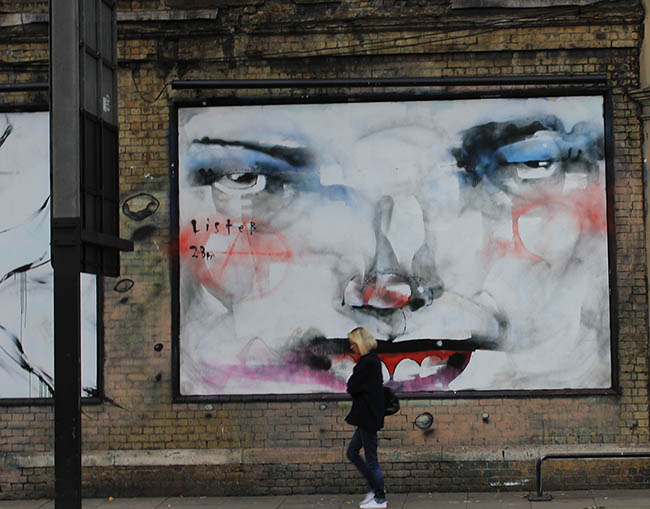
Great Eastern Street (Nov 2012)
Street Art London: OK, next question. Is there anything in particular that you like about painting in London.
Lister: That’s a good question, I like the fact that it is cloudy here as the sun just bugs me. I like that a lot. The energy is good here. People know things. There are so many talented artists here, I don’t get bored here, I see new things here constantly.
Street Art London: Anything else?
Lister: Well… that’s inappropriate. Jokes are not right. I tried to make a body of work about jokes you know.
Street Art London: That’s tough.
Lister: It was rough man… I mean you get them off the internet. [Lister tells a joke].
Street Art London: That’s awful.
Lister: And then you make a painting about that and you’re the bad guy. I am interested in the fine line between intention and inspiration. Can someone else be blamed for being the source of a concept or are you responsible for giving birth to it in a new form. I’m interested in moral equations like that.

Lister Tag on Shoreditch High Street (2011 – now gone)
Street Art London: Can one person be responsible for a concept? Is it possible?
Lister: Yes, absolutely they can. It’s called copyright.
Street Art London: But in the broadest sense all ideas come from certain influences and the environment.
Lister: A beautiful thing that Chuck Close said: “Inspiration is for beginners, the rest of us just get to work”. I like that one.
Street Art London: So that means that inspiration is what…
Lister: Something that students talk about to buy candles. I don’t know. Inspiration is things that are around but regardless of that fact painters are just going to get on with it. Less is usually more. If I have got one pen in my bag I’ll draw more than if I have 15 pens. Options can be a devil and limiting. Isn’t that crazy, a contradiction. And photoshop, go through those filters, I mean, fucking hell. If I’m walking in to a store I am only walking in there if I know what I am looking for.
Street Art London: Well tell us about the colour palette that you use. It usually white, blue, black and red.
Lister: That’s for my street works.
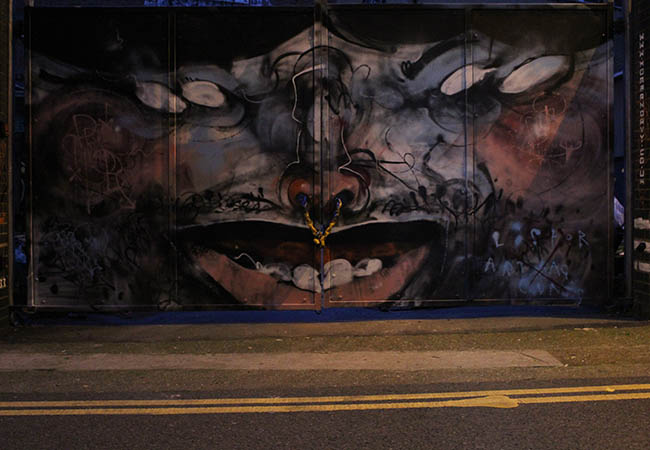
Christina Street (Nov 2012)
Street Art London: Well tell us about your characters, it looks like the same person.
Lister: I mean I just enjoy doing it. It’s fun and I find new ways to change it even if it doesn’t look like it. I am finding new forms in my motion and it’s comfortable. I mean when you undercoat for more painting, which is really what my craft is… I am sure that I have had more painting painted over than are still alive, and then you know, you want to have fun. I mean when I am in my lab with my canvases and in my sketchbooks and life drawing, thats when I test myself. Out there, thats fun for me. If I played golf I’d go and play golf and then I’d go back to the office and work on that data sheet report for… you know what I mean. Dude has a job, dude plays golf. Street art is like golf for me and then I go back to the lab. I enjoy street art and I do it with my friends.
Street Art London: So gallery and street are quite separate?
Lister: Absolutely, in my studio practice I am working hard to think about what’s this shit is all about, about bodies of work, about building shows. I just choose not to bless the street with that. I don’t need to exhaust myself like that. I like to do things that are fun. I’m lazy, what are you going to do?
Street Art London: Nothing, just going to ask you about it… [laughs]
Lister: No, the short answer, is that I am terribly lazy and I am terribly boring.
Street Art London: Well, that’s just like your opinion man. It’s a bit surprising that you think there is no link.
Lister: Sure, there’s a link. I am the link. But I don’t put a pressure on my street works to really perform like I need my studio pieces to work. My street work is golf, its just a fun thing that I do. I don’t take it that seriously.
Street Art London: So it’s like a release, going from the interior of the studio to the world and the ether.
Lister: Absolutely it is and I can use materials in a much more quenchable and tangible way. In the street is really where I can grab those cans and really cover some shit. In the studio, you make a mistake and it can take a while for you to get back to where you started. The studio is concentrated and calm and only has moments of violation. The streets are alive and I am just a little atom just shaking in it and I just hold on to something because it’s a ride and sometimes they want to beat me. Sometimes the paintings try to beat me and I can’t let that happen. I am ready for them to try to fight back.
Street Art London: You don’t want to be beaten by a painting.
Lister: You don’t want your shit stinking up the street. You have to have good style 24/7, it’s a wild ride out there.
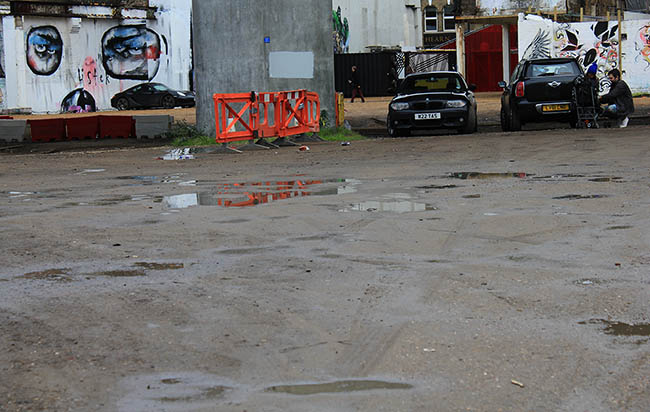
Holywell Lane Car Park (Nov 2012)
Street Art London: What do you think the importance of street art and graffiti is?
Lister: They are very important. Graffiti is the final frontier of true artistic integrity where you risk everything and give everything for nothing and no-one except for yourself. When you hear about graffiti writers going to jail it’s disconcerting that society is at that level. Yes, it’s important. People need to feel free, not to litter in the streets but sure to draw in the streets. It’s a law not to wear a helmet in my country, there is something a little wrong with that. I don’t know maybe not. There are so many contradictions and rules. It’s very important, people should be free to draw. I am over schooling peeps though. I just do it in front of people and tell them to mind their own business. You have to take their energy and switch it around at them.
Street Art London: Like Judo.
Lister: Yeah, exactly. Or you just absorb it and that’s fine. Sometimes they need that. Or sometimes I will just swing the mirror at fools. They don’t really understand why they are doing it. So they turn into a Matrix. Some authoritarian figure rolls up on you with some do-gooder renegade shit. They don’t even know why they are doing it and an agent flips out of them and the next thing you know you are dealing with some hothead. Thought it was some grandma, and she’s hitting you or something, it’s a trip right? And they don’t know why they are doing it.
Street Art London: Where do you see street art in the near future, 10, 20, 50 10 years?
Lister: I figure it will be holographic. I think that someone is going to kill it and then someone else will come along and bring it back to life. Maybe that dude from Blink 182. I also heard that Nick Cave was doing street art. I heard that he actually bought street art and now you have to pay him to even draw on the street. You know what, all I know is that I made a boomerang shaped iPhone and called it an iPhonerang… and I let it ring.
Street Art London: Did it come back?
Lister: Good question. Well, short answer: yes.
Street Art London: Have you copyrighted it yet?
Lister: What does copyright even mean? I just thought if I invented it first that was alright. But no, there are all these sneaky peeps.
Street Art London: You have to get a patent man.
Lister: I don’t know.I’m a small time guy with small time travel making plans. So anyway, that’s my iPhonerang. And what was the new word I was working on? Not procrastibation.
Street Art London: Nice.
Lister: I forget, you know new words and pianos that don’t work.
Street Art London: Do you make up a lot of new words?
Lister: I just like to think of absurd things that fit well together. It’s almost like eating a chicken nugget and an onion ring and calling it a chicken ring.
Street Art London: To come up with good concepts you have to put together disparate objects.
Lister: Sure, and then patent them.
Street Art London: And then sue anyone…
Lister: Well of course, I am hunting on the web all day long to find out who is biting me so I can sue them and get into a big law suit. I am in seven lawsuits right now, I don’t even sleep at night. No, I would hate that to be my life. You have gotta move forward.
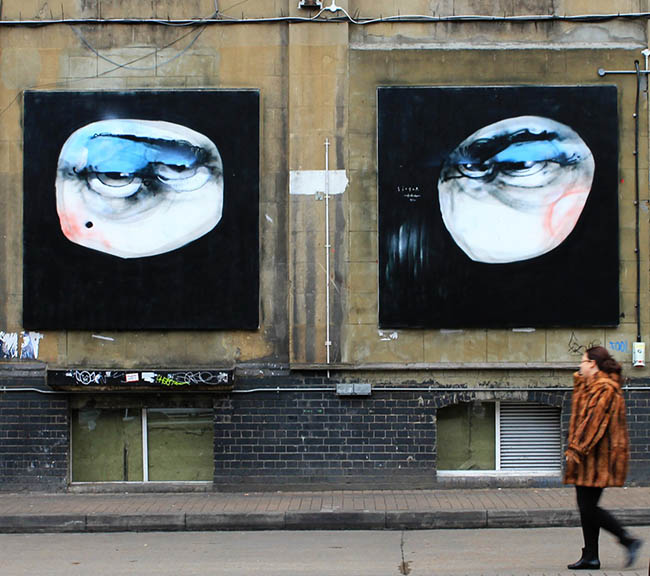
Truman Brewery (Nov 2012)
Street Art London: What are your thoughts of the increasing numbers of advertisers using street art?
Lister: Well, I think it is very interesting. It will definitely depend on a lot of things. The definition of street art is so broad that it is hard to be general about an opinion. I would say that if someone asked to use my artwork on a social studies document for Noway I would say yes. If North Korea asked to use it I would say no.
Street Art London: What about Apple or Coca Cola?
Lister: Well, I mean I use Apple and I have drunk Coca Cola and it may rot my teeth. I’m against people taking advantage of other people.
Street Art London: Do Coca Cola and Apple do that to an extent?
Lister: Well, they own all the spots for sure. But it’s an interesting question, how do I feel about it. If the artist is being paid and they want to label themselves as that then I don’t care. It’s not something I would do. I have been paid by companies to do jobs and I don’t have an issue with that.
Street Art London: So it’s bread and butter?
Lister: Hopefully everyone is getting something they want out of it. I used to stack shelves for money and push trollies for money. I used to work for companies and get treated like shit and paid shit. I don’t see it being any different. Yeah, it’s survival. It’s the artist that has to sleep and live with themselves. I just sit around and masturbate cry and pour Coca Cola on myself and get sticky.
Street Art London: While checking facebook on your iPhone?
Lister: Always on facebook, I have it on my face. I have it strapped to my face. And a mirror. A mirror and facebook. I have my iPhone taped to my head and a mirror that comes out over my face so I never forget what I am. All I ever ask myself is. Who are you? Who am I? But I know what I am.
Street Art London: I just got a mental image of that. It could make a good painting…
Lister: Well actually, I try to operate the opposite of that. I try to look in the mirror less, forget what I am, not who I am. I’ll work on that bit.
Street Art London: I guess, that’s it. Thanks.

you rock lister!!!